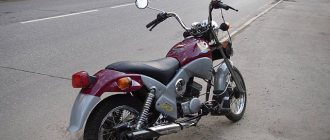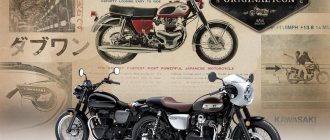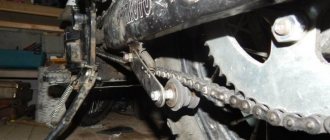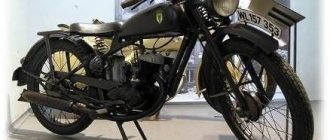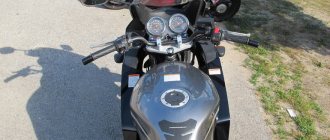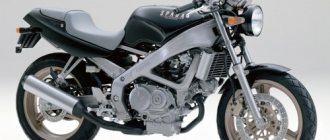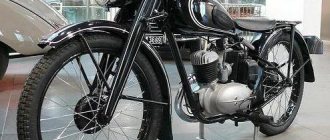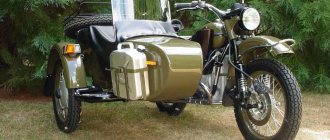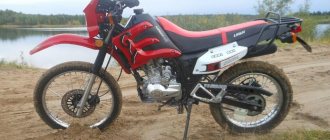The Java 350 motorcycle was created in Czechoslovakia, a now defunct country, and it was actively supplied to another now defunct state - the USSR. Nowadays it is vanishingly rare to see it on the road, but some thirty years ago it was the ultimate dream for many, many motorcyclists. They traveled on it on long journeys throughout the Soviet Union, carefully wiped it with a cloth after the trip, and sometimes even passed it down by inheritance with the words “Keep it as I kept it!” Nowadays they don’t make such impressive technology anymore...
Design
Not a single biker born at least 30 years ago will confuse this model with any other. The recognizable silhouette with an abundance of chrome and a long, flat seat, a seemingly chopped off taillight and matte aluminum engine covers sunk into the soul of many of us even in childhood or adolescence. The Java 350 differs noticeably from Soviet bikes in being less heavy and more graceful.
Before the crisis
A further development of the model was the Jawa 350 typ 639, launched into production in 1990 and a year later giving way to the Jawa 350 640 modification on the production line. The features of this machine include the front disc brake that appeared in later versions.
There were no major changes in technical parameters. This was the last modification, the production of which was launched before the collapse of the USSR. As for the Java 350 sport, contrary to popular belief, such an option was never produced. Only motorcycles with an engine capacity of 250 cc were awarded the sport prefix. cm.
Specifications
It was not for nothing that Soviet motorcyclists dreamed of this model! The Java 350's technical characteristics are quite good, especially for its time, although now they look hopelessly behind. But this motorcycle was first released almost 40 years ago, and it would be unfair to demand that it meet modern standards.
Engine
The simplest (but for its time - very progressive!) 2-stroke 2-cylinder engine requires gasoline with added oil to be poured into the gas tank so that the mechanisms can be properly lubricated. Power – 26 hp , and this motor is capable of accelerating the motorcycle to a maximum speed of 130 km/h . The two-stroke power unit does not have a long service life, but it is still quite durable.
Transmission
The gearbox does not have 5 gears, as bikers are used to these days, but only 4. But the gear ratios are quite long, so they are enough. And in everything related to reliability, the Java 350 gearbox can serve as a role model for many Chinese defectors, who in the 21st century manage to rivet motorcycles with gearboxes that jam at every tenth shift.
Chassis and brakes
The steel frame with the entire structure described above rests on four standard shock absorbers - two at the rear plus a fork at the front. There are no settings provided, which was the norm for the 80s of the last century. The brakes are also simple, drum, and there is no disc brake even on the front wheel. The braking distance is quite significant, since the bike weighs a lot.
Electronics
a 12-volt battery was used instead of 6. This benefited the motorcycle - its electrical circuit is extremely simple, albeit archaic. Charging of the battery begins when the engine picks up speed from 1000 per minute and above, and is provided by a generator working in conjunction with a diode voltage rectifier. Compared to the previous model of the Czechoslovak plant, the generator has become as much as 2.8 times more powerful.
Weight and dimensions
The dry weight of the bike is quite large, 156 kg without a sidecar. In that era, no one particularly thought about the use of more modern technologies in order to reduce weight and, accordingly, improve power availability. However, compared to many Soviet motorcycles, the brainchild of Czechoslovak engineers does not seem heavy at all.
Controllability
These days, this bike would probably be called a " dual-purpose motorcycle ." It copes equally well with driving both on asphalt and on dirt roads, and even light off-roading is up to it, especially if you take care of purchasing suitable tires. If you compare it not with modern motorcycles, but with those that were produced at the end of the USSR, it will be very good.
Fuel consumption
The Java 350 is capable of running on any gasoline you can find. Don't forget to mix it with oil in a ratio of 40 to 1! And if you change the engine or some elements of the piston group, then the ratio should be 33 to 1, according to the manufacturer’s recommendation. Fuel consumption on the highway can reach 5 liters per 100 km , and in urban conditions it can rise to 7 liters.
Java 350/638 Lux
Java 350/638 appeared in 1985, and became a real symbol of excellence among Soviet motorcyclists. Java was head and shoulders above its Soviet counterpart, IZH Jupiter-5. And although the price was significantly higher, the motorcycle was in short supply. There were queues outside the shops to become the lucky owner of the dream.
Read other motorcycle reviews of the Honda CBR600RR: technical specifications, prices and reviews
Technical characteristics, for that time, were progressive. The two-cylinder engine produced 26 hp and was quite revvy. At that time, only IL Planet-Sport could compare with Java in dynamics, but was significantly behind in comfort. It should be mentioned that there was a “Lux” version, which had distinctive appearance features and was slightly different in the structure of the gearbox.
Motorcycle price
The cost varies from several tens of thousands of rubles to several hundred thousand , although the latter is rare. This kind of money is usually asked for a bike in perfect condition, in which everything is original, down to the last nut. But just in a living state, it’s quite possible to buy a Java 350 thousand for 20-25 rubles , with documents and at full speed.
Rare and beautiful
One should not think that Czech motorcycles were sold exclusively in Eastern Europe. Jawa products were also supplied to the West. In 1969, an export modification of the Jawa 350 Californian IV typ 362, 363 was developed, which featured an original design. But relatively few such machines were produced.
A little later, in 1970, they released a modification of the Jawa 350 U? typ 633/1 Bizon, the characteristic features of which were a specifically shaped fuel tank and an abundance of compartments for storing tools and luggage. Today such a bike is a rarity, and if you happen to have a similar model at your disposal, then, unlike some Izh Planet-5, its tuning will be simply madness.
Repair and tuning
All Soviet-era equipment, even imported, is distinguished by its simplicity of design. This is both good and bad. Maintainability in this case goes hand in hand with outdated technologies, which these days are not used even by Chinese and Indian motorcycle manufacturers specializing in extremely low-cost equipment.
Repair
Who will drag Java 350 to the service? Such motorcycles are repaired in the garage, with love and strong words when something doesn’t work out. But seriously, even an inexperienced motorcyclist can understand the design of a Czechoslovakian bike, because it is extremely simple. The wear resistance of some components is low, but they are very easy to repair or replace.
Spare parts
It is very difficult to find original spare parts for a model that was discontinued a long time ago, and you only need to look for it on message boards, owner forums, and so on. They are almost never sold in stores, although there are Chinese analogues of unknown quality. However, they are still not suitable for restoring a motorcycle to its original condition.
Tuning
In the past, this bike was often tuned, especially in rural areas, but now it seems blasphemous. Such motorcycle equipment, which has survived to this day, needs to be carefully restored, and not turned into a traveling exhibit of the “Collective Farm Tuning of the Year” exhibition. And those who do not agree with this, and intend to turn an old Java into a “chopper type” or “sportbike type” with the help of an angle grinder and a sledgehammer, need to be beaten for a long time and thoughtfully with an adjustable wrench until they realize the fallacy of their intentions.
Motorcycle modifications
- Java 350 634 . The first modification to replace its 250 cc predecessor on the production line. Produced since 1973.
- Java 350 638 . The most famous version, produced since 1984. Because of the flat seat, it received the nickname “bench”. In fact, this is a slightly modernized and modified Java 634 6, which was produced a year earlier and was a transitional model.
- Classic Sports . The revived bike was shown to the public at an exhibition in 2015. The appearance has been greatly modified to suit the “cafe racer” style, popular in Great Britain in the 60s of the 20th century.
But rumors about the existence of such models as Java 360 or Java 380 (if we talk about cubic capacity figures) are nothing more than rumors that have been circulating on the Internet since its invention. No such models ever existed, although the old Java 350/360 is sometimes called simply "360", despite the fact that this is incorrect.
Forward movement
Few people know about this, but the history of a motorcycle with this name began back in 1934. The bike that appeared at that time was equipped with a single-cylinder engine with a power of 12 hp. s., four-speed gearbox, weighed 125 kg. and accelerated to a speed of 100 km/h. He participated in international competitions and won, proving his quality. It was called Jawa 350 SV.
The war made adjustments to the plans of the Czech manufacturer, and the model, which received the Java 350 type 12 index, appeared only in 1948. Due to certain circumstances, it did not last long on the assembly line. The wide Russian consumer had a chance to get acquainted with the next modification - Java 350 354/06, launched into production in 1954. It is this successful car that should be considered the first line in the success story of a popular brand in our country.
Advantages and disadvantages
The Java 350 needs to be compared with contemporary motorcycles, and not with models produced today. And for its era, this bike was, without exaggeration, magnificent! It was not for nothing that it was so popular in the USSR, despite the fact that Soviet motorcyclists had to order spare parts for it from the allied Czechoslovakia using various tricks.
Advantages
- Power . All sorts of “Voskhods” and “Izhi” could not compete with the Czechoslovak motorcycle on the road.
- Significant service life of the engine and CPG , noticeably longer than most Soviet bikes.
- Moderate mass , less than that of the Ural or Jupiter.
Flaws
- Difficulty finding spare parts these days. You can find everything, but you have to run.
- Compared to modern competitors, Java 634’s technical characteristics cannot stand any comparison even with the “Chinese”. The 638 model, however, does the same.
- It’s simply a pity to use the completed Java 350 as a vehicle for every day.
Next step
But time took its toll, and the management of the Czech company decided to make serious changes. In 1973, motorcycle enthusiasts had the opportunity to get acquainted with the Java-350 type 634. On the new bike, the frame design was changed and the engine design was seriously redesigned, increasing power to 23 hp. With.
The maximum speed indicated in the technical description, despite the weight gain of up to 160 kg, increased to 125 km/h. True, fuel consumption has also increased, amounting to 4.5 liters of gasoline per hundred kilometers at a speed of 80 km/h. The advantages of the model are:
- Ease of control and stability at high speeds, which, combined with a comfortable suspension and comfortable seating, had a beneficial effect on the fatigue of the motorcyclist. It was possible to cover a considerable distance behind the wheel without any problems.
- Operational reliability and solid design life.
The main disadvantage was considered to be the high price.
Owner reviews
In my youth there was such a device, I don’t remember the year of manufacture, I never had any documents, but I drove it in the 90s, and even then it was far from new. With Java, I was always the first guy in the village)) This is not Minsky with Voskhody... The horse is fire! On the highway it can easily go over a hundred, but if desired, it can also rush along an intersection normally if the tires are adequate. As far as I remember, it didn’t break much, except that the carburetor had to be adjusted again from time to time, something was wrong with it. But still, the spendthrift is a legend! Arthur, Nizhny Novgorod.
Last year I bought myself an old Java for restoration, the seller gave me 634 not running as a load, so I’m doing a little of both. The old woman is already on the move, I’m slowly finishing 634, bringing it to mind. It’s difficult to find original spare parts, but I don’t want to install non-original ones, the goal is to restore it to collectible condition. I am pleased with the very simple and well-thought-out design; compared to modern motorcycles, the difference is huge. Evgeny, Lipetsk.
I still ride this motorbike; it is parked at the dacha and spends the winter there right in the barn. In the city of Golda-poltorashka there is, 180 km to the dacha, but there are no asphalt animals around there at all, the goldolet on local roads is only ruined, so I drive there in Java when I arrive. The moped is indestructible; after wintering in a snow-covered shed, it always starts, you just need to charge the battery and throw in fresh gas. Previously, they knew how to make real equipment)) Dmitry, Ryazan.
Similar models
- Izh Planet 5. An excellent motorcycle for its time, quite powerful and unpretentious.
- Izh Jupiter 5. The characteristics are similar to the above-mentioned brother, but differs from it in having a 2-cylinder engine instead of a 1-cylinder.
FAQ
- Do the spare parts for 634 and 638 fit together? For the most part, yes. But parts for a more recent model, that is, 638, are more often found on sale.
- How many horses are there in Java 350? Exactly 26 fast horses. True, no one remembers exactly how the Czechoslovak plant measured power, at the crankshaft or at the rear wheel.
- I have an old anniversary car in my garage, I got it from my grandfather, it hasn’t started for about twenty years, but it looks decent. Does it make sense to invest in restoration for the purpose of selling? Yes, if the bike is in overall good condition. Collectible pieces can be quite expensive.
- What is the lifespan of this motor? There is no exact data, but there are reviews from owners who claim that the engine runs 30,000 km or more without repairs.
- How much does the Java 350 motorcycle weigh? Curb weight with all fluids and other things is about 185 kg, dry weight is about 156 kg.
Price for Java 350/638
10 years ago, the Java 350/638 model was discontinued, but continues to be popular among Russian motorcyclists. Prices for used motorcycles range on average from 14,000 to 35,000 rubles. A 1988 model can be purchased for $322, a 1991 motorcycle for $1,500.
Screenshot of prices from the avito service
Screenshot of the price of a Java 350/638 motorcycle from the moto.auto.ru service
Conclusion
Comparing the Jawa 350 motorcycle with modern bikes is incorrect and even unfair. In terms of technical characteristics, this model, developed half a century ago, is inferior to any motorcycle that can be bought in showrooms now, even Chinese. But for their time, the Czechoslovakian steel horses were magnificent, and many motorcyclists have the warmest memories of them. If, when you look at this recognizable silhouette, nostalgia rolls over you, and you want to lock yourself in the garage and start servicing this greeting from the last century, then it’s worth buying it to pamper yourself. The completed Java 638 will become not only an excellent toy for real men, but also just a good weekend motorcycle.
Specifications
| Maximum engine power: | 26 HP |
| Working volume: | 350 cm3 |
| Motor type (cylinder arrangement, number of strokes): | 2-cylinder, 2-stroke |
| Number of cylinders: | 2 |
| Number of valves: | |
| Intake type (Injector / Carburetor): | |
| Bore and stroke: | |
| Starting system (Electric starter, kick starter): | |
| Maximum speed in km/h: | 130 km/h |
| Cooling system: | Air |
| Transmission (gearbox): | 4-speed |
| Clutch (Dry / Wet): | |
| Drive unit: | Chain |
| Frame: | Steel tubular |
| Chassis | |
| Suspension (front/rear travel): | |
| Brakes (Front/Rear): | |
| Wheels / Tires / Rubber: | |
| Dimensions and weight | |
| Dimensions (Length / Width): | |
| Seat height: | |
| Ground clearance: | |
| Curb weight: | |
| Wheelbase: | 1335 mm |
| Weight: | 156 kg |
| Fuel tank capacity: | 17 l. |
| Battery capacity: | |
| Year of release: | |
| Country of Origin: |
Family values: motorcycle Jawa-350 “Droplet” (photo, video)
“And yet, red or black?” - with this thought, Vladislav Gapanovich, back in 1966, was choosing a motorcycle for his son at the Sporting Goods store. It’s amazing how a person’s choice subsequently determines the fate of entire generations! What if Vladislav had chosen black Pannonia, perhaps this material would not have existed. Maybe then the international retromoto festival “Kola Chasu” would not have taken place in Belarus, who knows... But the choice fell on the red Jawa.
In the USSR, owning a Java meant joining the motorcycle elite. In the world of motorcycles “Minsk”, “Voskhod”, “Ural” and “Izh”, the imported Czechoslovak “Kapelka” stood out with its progressive design and good characteristics. The motorcycle still delights today: an abundance of chrome, rounded shapes, a semi-automatic clutch, a semicircular speedometer that works in the other direction. The kick starter and gear shift foot are one piece. The “heart” of Jawa is an 18-horsepower 350 cc two-stroke engine, which accelerated the motorcycle well at that time.
Today our guest is Vladislav’s grandson Vitaly Gapanovich, owner of the Jawa-350 mod. 360, as well as one of the ideological inspirers and organizers of the international retromoto festival “Kola Chasu”. The owner's short story about his restored motorcycle is in the video.
— The motorcycle is unique in its own way, it was very popular in Soviet times and today is one of the most interesting examples of the world motorcycle industry. My “Java” was produced in 1973 - it was in this year that the production of the model, which was developed back in the 50s, was discontinued.
The design is simply amazing. The headlight, tank, engine, sidecar are made in the same style with smooth transitions and flexible lines. What is typical is that the steering wheel, headlight, instrument panel and ignition switch are connected in one unit. There is also a backlit speedometer scale. The ignition system has also been thought out: if the battery fails, the key is turned to the left, ignition is carried out directly from the generator - this way the motorcycle can be started from the “pusher”.
“My grandfather bought a Jawa-250 for my father after he graduated from university and got a job,” Vitaly continues the story. — My father had to travel 25 kilometers every day. Therefore, all the funds that the family had were collected to buy a motorcycle and went to Minsk. My grandfather did not have much knowledge of technology, but he was a creative person - a good woodworker. A relative and I went to the Sporting Goods store, where motorcycles were sold at that time. And there stood a black Hungarian Pannonia and a single-cylinder Jawa-250. Black or red? Grandfather Vladislav, without a shadow of a doubt, pointed his finger at the red motorcycle, it looked so fascinating at that time. And somehow this motorcycle has been with me throughout my life in my soul. And my dad always took me fishing and mushroom hunting... Now this “Java” is in my garage, waiting to be restored. I promised myself that I would get my hands on my father’s motorcycle, and that would be a different story.
Vitaly purchased this particular copy in the early 2000s. According to him, the effort and money invested in it was commensurate with the cost of purchasing an average used car. A lot of time was spent searching for parts - finding spare parts for a half-century-old motorcycle today is by no means easy. — The task was set to restore 100 percent of the original appearance of the Jawa-350. The engine was overhauled, the motorcycle itself was repainted, and some parts had to be nickel-plated again. It was difficult to find a stroller cockpit in good condition, since for this model it is made of fiberglass to reduce weight. The stroller weighs only 70 kilograms, but in case of contact, for example, with a curb, its body easily bursts. That's why there are few of them left. If you consider all the time and money to restore such a motorcycle, you realize that this is an expensive pleasure. The market price for such specimens today is quite high.
A few words about the technical characteristics. The maximum speed of the “Droplet” is 120 km/h, fuel consumption at an average speed of 60 km/h is about 3.6 l/100 km. Weight - only 139 kg. The advantages include a well-thought-out design, reliability and ease of maintenance. On any trip, "Java" gives only pleasant impressions. And if something happens, you can fix it “on your knees.” — They constantly ask me to sell my motorcycle: “Oh, cool! This is my dream, my childhood dream, sell it!” For some it was youth, and this person has a lot of life stories connected with “Droplet”. But I’m definitely not going to sell the motorcycle. I restored it to please myself and others.
There are four gears, between each two there is a “neutral”, which is quite convenient. The clutch is semi-automatic - there is no need to squeeze it when shifting up. The dynamics, of course, cannot be compared with modern motorcycles, but in the old days the Jawa-350 was one of the fastest in the USSR.
“I’m already used to the fact that the motorcycle is noticed.” Almost everyone in the city pays attention to him. I'm glad that people smile. It’s humanly nice that my motorcycle lifts someone’s spirits.
The quality of the chrome plating of the parts, the neat assembly - everything indicates that it was made with high quality and with love. Special thanks to the designers who endowed the motorcycle with timeless beauty. And having acquired its original appearance thanks to modern restorers, “Java” again makes new generations fall in love with it. Still, this “cherry fruit” is very pleasant - the fruit of love of talented Czech engineers.
Yuri GLADCHUK Photo by Olga-Anna KANASHITS Video by Anton SHELKOVICH ABW.BY
Notes in the margins
Of course, this motorcycle does not have turn signals. Signals are given the old fashioned way, by hand.
The engineers provided the possibility of installing a left rear view mirror, since the motorcycle was not equipped with one. But it was difficult to find it during the years of Soviet shortages. It was even more difficult to find the windshield, stroller and side bars.
Piece of art! Notice how carefully the carburetor is hidden from prying eyes.
According to personal observations, dogs especially “love” two-stroke motorcycles.
Speedometer, battery low indicator light and neutral indicator light, mileage indicator, instrument panel illumination - everything in Jawa is grown-up.
Vitaly’s motorcycle starts only with one click. The kick starter and gear shift foot are made in one piece. In those years, it was considered particularly foppish to start a motorcycle not with your foot, but with your hand. Try doing this with Voskhod!
There is also a place for tools here. Unlike some Soviet motorcycles, access to the sidewalls is only possible with a key.
The rear suspension is pendulum type. The rear shock absorbers are adjustable in height and, accordingly, in stiffness.
A stroller for Jawa-350 is a very rare thing today. There is space for luggage under the lock.
Czech engineers have provided the ability to lock the steering wheel using a lock.
"Kola Hour" - international retromoto festival
“We came up with it with Oleg, my brother,” Vitaly Gapanovich says about the event. — We came up with the idea a long time ago, about seven years ago. The philosophy of the festival is to unite people who are passionate about retro motorcycles, because now there are more and more of them. Last year we organized the first international retromoto festival “Kola Chasu”. This year the festival will be held on July 19 at the base. Participants come to us from Poland, the Czech Republic, Lithuania, Latvia, Hungary, Russia, Ukraine and all corners of Belarus on motorcycles from the beginning of the twentieth century to 1984. I guarantee a good mood, a retro atmosphere and vivid impressions. And if, at the end of the festival, you want to buy a retro motorcycle or even restore it, we will assume that we did not create the festival in vain!
Program of the festival “Kola Hour 2014”:
- exhibition of retro motorcycles;
- retro motor rally "Syabry";
- 18th gathering of friends of "Java";
- an amateur retro fashion show and the “RETRO FASHION” competition (participating in the audience who came to the festival in retro outfits);
- festival nominations: “Dzed” (the oldest participant on a motorcycle), “Unuk” (the youngest participant on a motorcycle), “Pan Shlyahu” (the farthest distance to the retro motorcycle festival “Kola Chasu 2014”, which was traveled by a participant on a motorcycle produced before 1984 ), “MOTA-Panna” (a girl on a motorcycle), “Kola Chasu” (the oldest motorcycle), “Lepsha Restauratsyya” (the best restoration of a motorcycle), “Turyst” (the best equipment of a motorcycle for motorcycle trips), “Retrasimpatiya” (from the workshop Yuri Shif Custom), “Ratrashyk” (the most original correspondence of the image of the owner/driver to the era of his motorcycle);
- various attractions for children and adults from CET "Stankovo" and festival partners.
Special guests of the festival:
- Yuri Shif Custom;
- a 1924 Ford Model T;
- Vladimir Yarets is a legendary motorcycle traveler from Belarus;
- veterans of the motorcycle movement of Belarus (BSSR/USSR);
- Sunny Bus (retro bus; model 1968).
How to get to Stankovo is written here.

